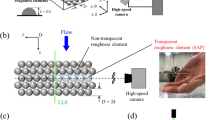Abstract
This paper aims to study of the efficiency of windbreaks composed by three dimensional arrays of pillars and used for snow deposition. Windbreaks and snow fences are commonly designed as two dimensional porous fences. This gives good efficiency, but might in some cases be regarded as architecturally boring. It also represents an obstruction to human traffic, and is sometimes difficult to integrate in the landscape architecture. The air flow around three different geometrical configurations of pillars is analyzed. The three arrangements include four and six rows of pillars and a sculptural representation of a Saami (indigenous people of northern Scandinavia) labyrinth. The numerical simulations of wind and snow deposition show that the flow pattern in the arrays is not very sensitive to wind speed. The four row array seems to produce snow drifts which are longer, and have the maximum height located further downwind than a common 50 % porous snow fence. The results of the windbreak, inspired by the Saami labyrinth, show that there is a large variation of the friction velocity within the labyrinth. Based on the results, such arrangement can be regarded as an alternative for landscape architects aiming to shelter a specific area. However, optimisation studies on internal structure of the size, orientation and shape of the pillars should be performed based on local wind climate. The methods outlined here seems suitable for such studies.











Similar content being viewed by others
References
Heisler GM, DeWalle DR (1988) Effects of windbreak structure on wind flow. Agric Ecosyst Environ 22–23:41–69
Sudmeyer RA, Scott PR (2002) Characterisation of a windbreak system on the south coast of Western Australia. 1. Microclimate and wind erosion. Aust J Exp Agric 42:703–715
Sturrock JW (1969) Aerodynamic studies of shelterbelts in New Zealand. 1. Low to medium height shelterbelts in Mid-Canterbury. N Z J Sci 12:754–776
Loeffer AE, Gordon AM, Gillespie TJ (1992) Optical porosity and windspeed reduction by coniferous windbreaks in Southern Ontario. Agrofor Syst 17:119–133
Zhang H, Brandle JR, Meyer GE, Hodges L (1995) The relationship between open windspeed and windspeed reduction in shelter. Agrofor Syst 32:297–311
Zhou XH, Brandle JR, Mize CW, Takle ES (2004) Three-dimensional aerodynamic structure of a tree shelterbelt: Definition, characterization and working models. Agrofor Syst 63:133–147
Hanna SR, Tehranian S, Carissimo B, Macdonald RW, Lohner R (2002) Comparisons of model simulations with observations of mean flow and turbulence within simple obstacle arrays. Atmos Environ 36:5067–5079
Tabler RD (1994) Design guidelines for the control of blowing and drifting snow. SHRP H-381, US National Research Council
Tabler RD (2006) Three-dimensional roughness elements for snow retention. FHWA-WY- 06/04F, Wyoming Department of Transportation
Thiis TK, Gjessing Y (1999) Large-scale measurements of snowdrifts around flat-roofed and single-pitch-roofed buildings. Cold Reg Sci Technol 30:175–181
Beyers JHM, Sundsbø PA, Harms TM (2004) Numerical simulation of three-dimensional, transient snow drifting around a cube. J Wind Eng Ind Aerodyn 92:725–747
Tominaga Y, Okaze T, Mochida A (2011) CFD modeling of snowdrift around a building: an overview of models and evaluation of a new approach. Build Environ 46:899–911
Naaim M, Naaim-Bouvet F, Martinez H (1998) Numerical simulation of drifting snow: erosion and deposition models. Ann Glaciol 26:191–196
Yakhot V, Orszag SA, Thangam S, Gatski TB, Speziale CG (1992) Development of turbulence models for shear flows by a double expansion technique. Phys Fluids A 4:1510–1520
Katul GG, Mahrt L, Poggi D, Sanz C (2004) One- and two-equation models for canopy turbulence. Bound-Lay Meteorol 113:81–109
Clift R, Grace JR, Weber ME (1978) Bubbles, drops and particles. Academic, New York
Mellor M, Fellers G (1986) Concentration and flux of wind-blown snow. US Army Corps of Engineers, special report 86–11
Mellor M (1965) Blowing snow. U.S. Army Materiel Command, Cold Regions Research and Engineering Laboratory, Hanover, New Hampshire
Kind PJ (1981) Snowdrifting, Handbook of snow. In: Gray DM, Male H (eds) Principles, processes, management and use. Pergamon Press, Toronto, pp 338–359
ANSYS CFX-Solver Modeling Guide
Author information
Authors and Affiliations
Corresponding author
Rights and permissions
About this article
Cite this article
Thiis, T., Ferreira, A.D. Sheltering effect and snow deposition in arrays of vertical pillars. Environ Fluid Mech 15, 27–39 (2015). https://doi.org/10.1007/s10652-014-9356-1
Received:
Accepted:
Published:
Issue Date:
DOI: https://doi.org/10.1007/s10652-014-9356-1




